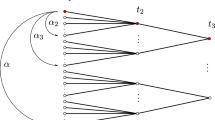Abstract
The application of flags to network coding has been introduced recently, see e.g. Liebhold et al. (Des Codes Cryptogr, 86(2):269-284, 2018). It is a variant to random linear network coding and explicit routing solutions for given networks. Here we study lower and upper bounds for the maximum possible cardinality of a corresponding flag code with given parameters.
Similar content being viewed by others
Notes
By an optimal target value we denote the target value that is attained in the extremum, i.e., the maximum or minimum depending on the formulation of the optimization problem.
Let us assume \(A_2^f(6,3;\{2,3\})\le 185\) for a moment. Inequality (10) then would yield \(A_2^f(7,3;\{3,4\})\le \frac{127}{7}\cdot 185=3356 +\frac{3}{7}\). Of course this can be rounded down to 3356, since \(A_2^f(7,3;\{3,4\})\) is an integer. However, as in the case of constant dimension codes the rounding of the Johnson bound can be improved using the theory of \(q^r\)-divisible codes, see [10]. More concretely, for each codeword \(\left( W_3,W_4\right) \) we just consider the plane \(W_3\). Since we assume \(A_2^f(6,3;\{2,3\})\le 185\) those planes cover each point of \({\mathbb {F}}_2^7\) at most 185 times. If the flag code has cardinality 3356 then not every point of \({\mathbb {F}}_2^7\) can be covered exactly 185 times, i.e., the missing points correspond to a multiset of points of cardinality 3, which in turn corresponds to a binary linear code of effective length 3. Since it can be shown that this code has to be 4-divisible, i.e., the weight of every codeword has to be divisible by 4 and such a code cannot exist, we could strengthen our argument to \(A_2^f(7,3;\{3,4\})\le 3355\). (A 4-divisible binary linear code of effective length 10 indeed exists.) For the details we refer to [10, Lemma 13(i)] and its preparing results and definitions.
References
Alonso-González C., Navarro-Pérez M.Á., Soler-Escrivà X.: Flag codes from planar spreads in network coding. Finite Fields Their Appl. 68, 101745 (2020).
Beutelspacher A.: Partial spreads in finite projective spaces and partial designs. Math. Z. 145(3), 211–229 (1975).
Cai H., Etzion T., Schwartz M., Wachter-Zeh A. Network coding solutions for the combination network and its subgraphs. In: 2019 IEEE International Symposium on Information Theory (ISIT), pp. 862–866 (2019).
Drudge K.: On the orbits of singer groups and their subgroups. Electron. J. Comb. 1, R15–R15 (2002).
Etzion T., Kurz S., Otal K., Özbudak F.: Subspace packings: constructions and bounds. Des. Codes Cryptogr. 88, 1781–1810 (2020).
Fourier G., Nebe G. Degenerate flag varieties in network coding. arXiv:2003.02002 (2020).
Gabidulin E.: Theory of codes with maximum rank distance. Probl. Peredachi Inform. 21(1), 3–16 (1985).
Glynn D.G.: On a set of lines of \({PG}(3, q)\) corresponding to a maximal cap contained in the Klein quadric of \({PG}(5, q)\). Geom. Dedic. 26(3), 273–280 (1988).
Heinlein D., Kiermaier M., Kurz S., Wassermann A.: Tables of subspace codes. arXiv:1601.02864 (2016).
Kiermaier M., Kurz S.: On the lengths of divisible codes. IEEE Trans. Inf. Theory 66(7), 4051–4060 (2020).
Kohnert A., Kurz S. Construction of large constant dimension codes with a prescribed minimum distance. In: Mathematical Methods in Computer Science, pp. 31–42. Springer, New York (2008).
Liebhold D. Flag Codes with Application to Network Coding. PhD thesis, RWTH Aachen (2019).
Liebhold D., Nebe G., Vazquez-Castro A.: Network coding with flags. Des. Codes Cryptogr. 86(2), 269–284 (2018).
Liebhold D., Nebe G., Vázquez-Castro M. Á. Generalizing subspace codes to flag codes using group actions. In: Network Coding and Subspace Designs, pp. 67–89. Springer, New York (2018).
Wang H., Xing C., Safavi-Naini R.: Linear authentication codes: bounds and constructions. IEEE Trans. Inf. Theory 49(4), 866–872 (2003).
Xia S.-T., Fu F.-W.: Johnson type bounds on constant dimension codes. Des. Codes Cryptogr. 50(2), 163–172 (2009).
Acknowledgements
The author thanks Gabriele Nebe for her comments and remarks on an earlier draft. Especially, the idea to study the quantity \(A_q^c(v,d)\) and compare it with \(A_q^f(v,d)\) was hers. Moreover I am indebted to the anonymous reviewers whose remarks and comments allowed me to improve the presentation of the paper.
Author information
Authors and Affiliations
Corresponding author
Additional information
Communicated by T. Etzion.
Publisher's Note
Springer Nature remains neutral with regard to jurisdictional claims in published maps and institutional affiliations.
Rights and permissions
About this article
Cite this article
Kurz, S. Bounds for flag codes. Des. Codes Cryptogr. 89, 2759–2785 (2021). https://doi.org/10.1007/s10623-021-00953-w
Received:
Revised:
Accepted:
Published:
Issue Date:
DOI: https://doi.org/10.1007/s10623-021-00953-w




